What are the development milestones of a 3-month-old baby?
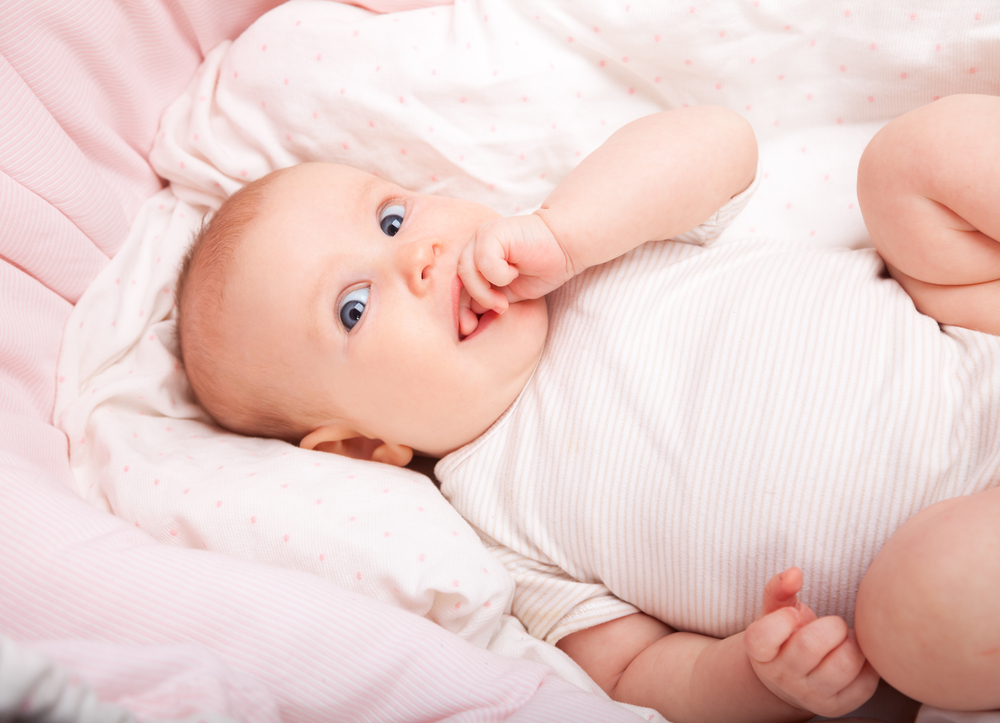
Your child is 3 months old. By this time, they have already developed a strong affection for their parents. They react with a smile, cry and sleep less, and their first character traits start showing. The baby gradually adapts to the world, and their daily routine becomes more organized and predictable.
All children grow at different paces. In this article, we provide indicative stages of child development that require particular attention. Don’t worry if your baby doesn’t meet these criteria very closely. They may be more or less advanced in certain aspects in comparison to their peers — this should all level out over time.
Contents:
- Physical development and new skills
- What should a 3-month-old baby know how to do?
- Basic needs: sleep and nutrition
- Emotions and sensorial organs
- Doctor’s tips
- Frequent issues and ways to resolve them. When should you be alarmed and when not?
- When is assistance required immediately?
- Development of a 3-month-old baby: tips for parents
Physical development and new skills
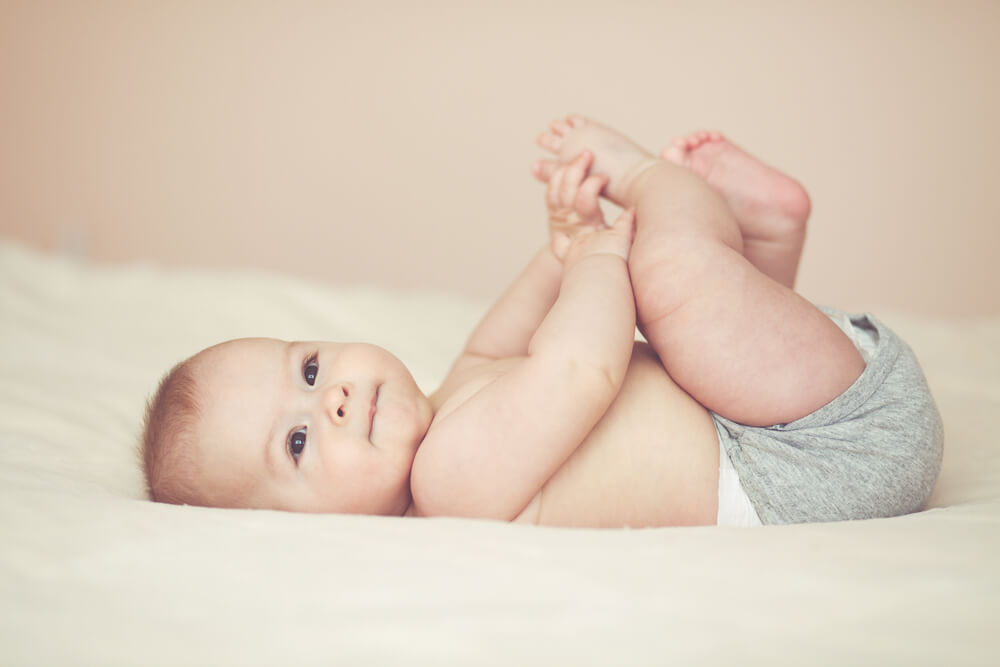
Prostock-studio/Shutterstock.com
By the age of 3 months old, the baby becomes much stronger physically. Parents start noticing changes in the development of their baby almost on a weekly basis.
By this age, the child has already learned to do the following:
- hold their head on their own;
- raise and hold their head for a long time in a prone position;
- support their upper body with their hands in a prone position;
- stretch their legs and kick them while lying on their stomach or on their back;
- put their hands and toys into their mouth;
- hold the toy and shake it (the child’s hand coordination is not yet developed).
Moreover, by the age of 3 months, some babies already have their fontanelle closed. The pediatrician will surely pay attention to this during a routine examination. If your baby’s fontanel is still noticeable, you should not panic, as it may get covered later. In the absence of other symptoms, this is not a reason for concern.
Height and weight
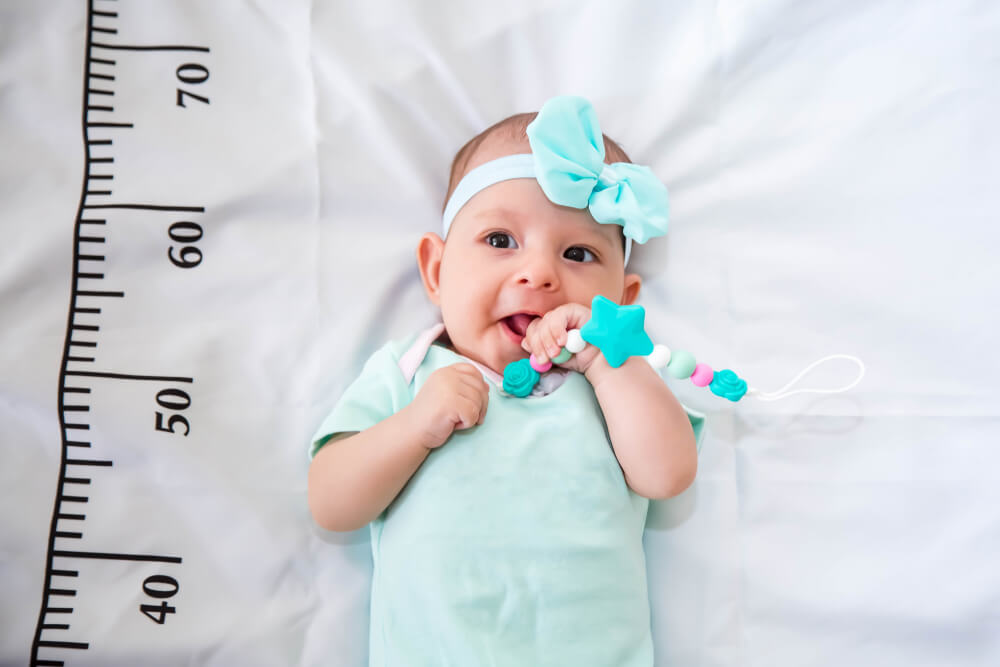
Prostock-studio/Shutterstock.com
Children grow very quickly in their first year of life. According to the studies of WHO, the average infant weight norm depends on the gender of the child. Boys are usually larger, nevertheless, girls with large weight and height parameters are also not uncommon. These findings highlight the fact that all people are different.
Average indicators of the relationship between the height and weight of children in the first 6 months of their life:
| Age of the child | Girls | Boys | ||
| Weight, kg | Height, cm | Weight, kg | Height, cm | |
| Newborn | 3 200 | 49.1 | 3 300 | 49,9 |
| 1 month | 4 200 | 53,7 | 4 500 | 54,7 |
| 2 months | 5 100 | 57,1 | 5 600 | 58,4 |
| 3 months | 5 800 | 59,8 | 6 400 | 61,4 |
| 4 months | 6 400 | 62,1 | 7 000 | 63,9 |
| 5 months | 6 900 | 64,0 | 7 500 | 65,9 |
| 6 months | 7 300 | 65,7 | 7 900 | 67,6 |
⠀
If your child is a little underweight or overweight, don’t panic. It is important that they grow and gain weight at a healthy rate. This is carefully monitored by a pediatrician, especially in the first year of a baby’s life. Parents should avoid weighing their baby at home too often for the sake of their peace of mind.
Average measurements of head and chest circumference for children below the age of 6 months old:
| Age of the child | Head circumference in cm | Chest circumference in cm | ||
| Boys | Girls | Boys | Girls | |
| 1 month | 37,3 | 36,6 | 36,3 | 36.0 |
| 2 months | 39,2 | 38,4 | 39,0 | 38,1 |
| 3 months | 40,9 | 40,0 | 41,3 | 40,0 |
| 4 months | 41,9 | 41,0 | 42,8 | 41,8 |
| 5 months | 43,2 | 42,0 | 44,3 | 43,0 |
| 6 months | 44,2 | 43,0 | 45,4 | 44,3 |
What should a 3-month-old baby know how to do

Prostock-studio/Shutterstock.com
At the age of 3 months old, the child becomes more harmoniously formed. It is important for parents to know about the main development indicators in order to help their child, and in case of health problems, to quickly notice that something is wrong.
Reflexes
By the age of 3 months old, the following reflexes gradually go away:
- Searching reflex. If you stroke the cheek or the corner of the baby’s mouth, they will turn their head in your direction and open their mouth slightly.
- Hand and head reflex. If you press your thumbs on both palms of the hand of the child, they will open their mouth and bend their head.
- Pronounced Moro reflex. When hitting the surface next to the child, the baby spreads their arms and squeezes their fists, after which they return to their original position.
- Whistling reflex. The child stretches their lips if you touch their upper lip.
If these reflexes remain after the baby turns 3 months old, this may point to some developmental abnormalities and issues with their nervous system.
Physical activity
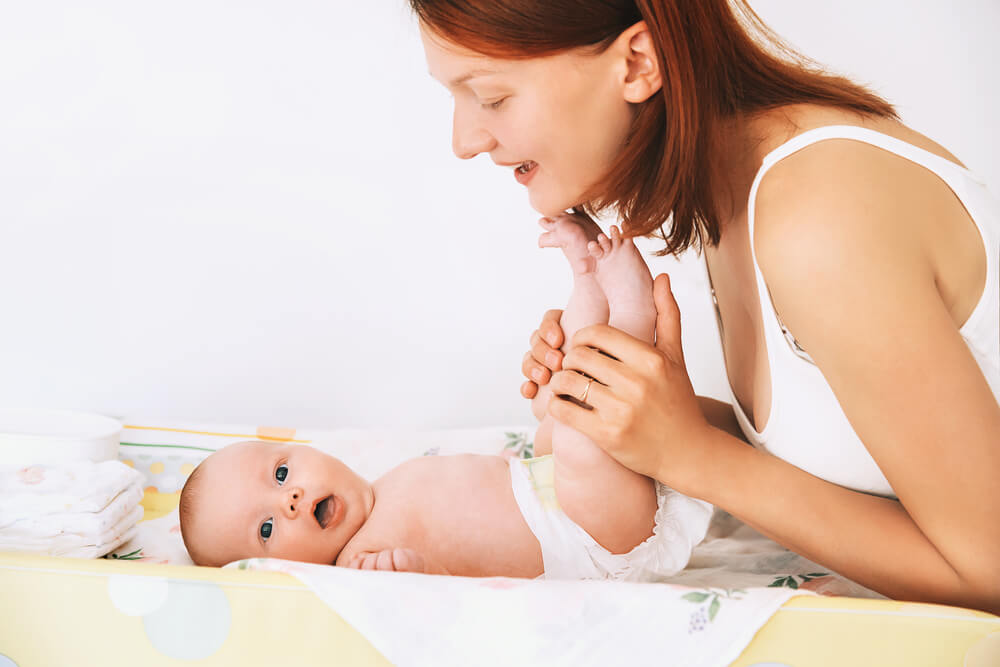
Prostock-studio/Shutterstock.com
The child starts trying to control their movements from a physical standpoint. They hold their head in an upright position. They tilt their head forward when lifted up. The range of the motion of their limbs is noticeably increased.
Changing diapers will now be more fun, but time-consuming. The child acquires a new physical skill of kicking their two legs up at the same time, and this amuses them very much. At this time, the baby begins to wave their arms and legs strongly and can knock down some objects around them with their little fists.
In addition, at the age of 3 months old, the baby already begins to sway back and forth, therefore, you have got to be careful: do not leave them unattended on the changing table or on the bed without a protective border.
Basic needs: sleep and nutrition
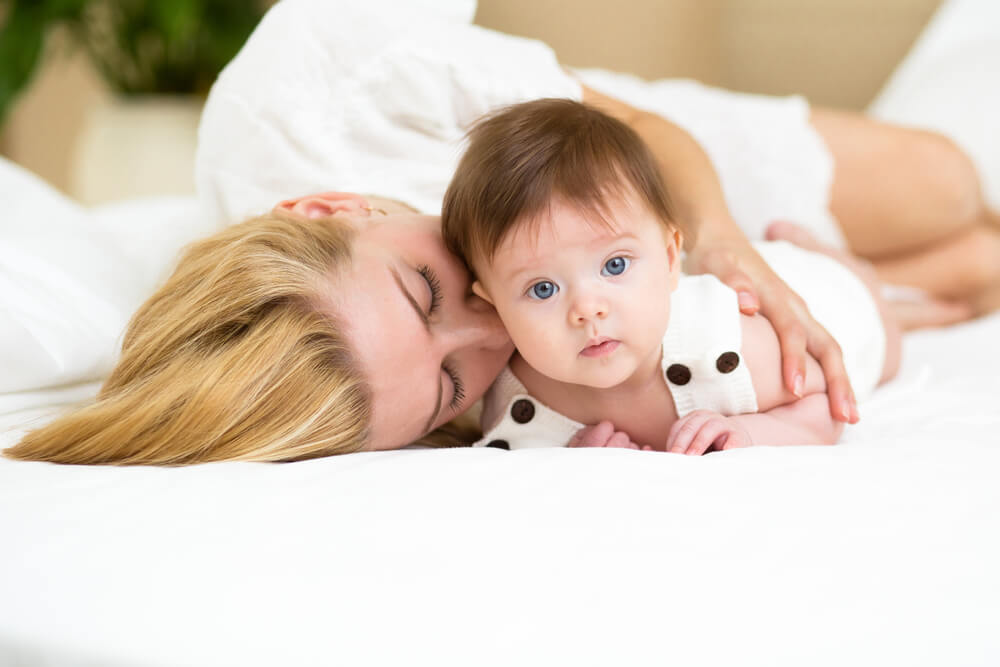
Prostock-studio/Shutterstock.com
Each child has got different needs in terms of their rest, however, on average, the baby needs 14-16 hours of sleep per day at this age, including daytime sleep.
The daytime sleep pattern of the child should already become familiar to their parents. Most 3-month-old babies sleep several times during the day for 1,5-2 hours.
Standard norms of sleep for a 3-month-old baby:
| Total number of hours in 24 hours | Nighttime sleep | Daytime sleep | The maximum duration of staying awake in between naps | |
| The number of hours of sleep | 14-16 hours | 9-10 hours with waking up to eat | 4-5 hours (out of the whole day) | 75-90 minutes |
⠀
Some children already begin sleeping at night for 5 hours in a row, whilst others continue waking up very often. This can happen for various reasons. For example, if your baby is breastfed, they will wake up to be fed more frequently.
The child may be also waking up when they’re going through a change in their sleep phases. Do not rush out to their room and give the baby a few moments. At this stage of life, being awake is normally for short periods of life and the baby will immediately fall asleep again by themselves.
The colic period should gradually stop by this time. You may be relieved to notice that the child has stopped waking up all the time, acting restless and crying loudly.
Healthy deep sleep

Prostock-studio/Shutterstock.com
By the age of 3 months old, you may notice that the baby begins to sleep well only when being moved around in a stroller or in their mother’s arms. Therefore, it is vital to establish healthy sleeping habits. Be sure to incorporate pre-sleep rituals into your life. This can be books, a lullaby, a relaxing bath, dimmed lights and other elements to foster a sleep-inducing environment. Do not forget to ventilate the room more often and maintain the right humidity levels in the place where the baby sleeps.
During this period, it is important to adjust the baby’s sleep pattern, so that over the next month, bedtime can be easily moved to 8-8.30pm. At the same time, it is important that the baby always wakes up at the same time, which has to be at 7-8 am. Such a routine will allow you to form a healthy and physiological daily routine for the whole family in the future.
Timetable and feeding norms
For the first 6 months of their life, all that babies need in terms of nutrition is breast milk or formula. If you are breastfeeding, consult your pediatrician about the dosage of vitamin D required for your baby. As a rule, the daily intake is up to 10 mcg for healthy babies.
During this period, most babies surprise their parents by growing very quickly, so you may start noticing that your baby has begun to eat much more. On average, a 3-month-old baby needs between 720 and 1200 ml of milk (this is 5-8 feedings per day).
For children who are breastfed, a six-time daily feeding schedule is recommended, which is to take place every 3-4 hours. It is important not to let the baby overeat in order for their stomach not to hurt. If the baby is formula-fed, it is preferable to feed them every 3-3.5 hours during the day, and in spaces of up to 6.5 hours at night.
Emotions and sensorial organs
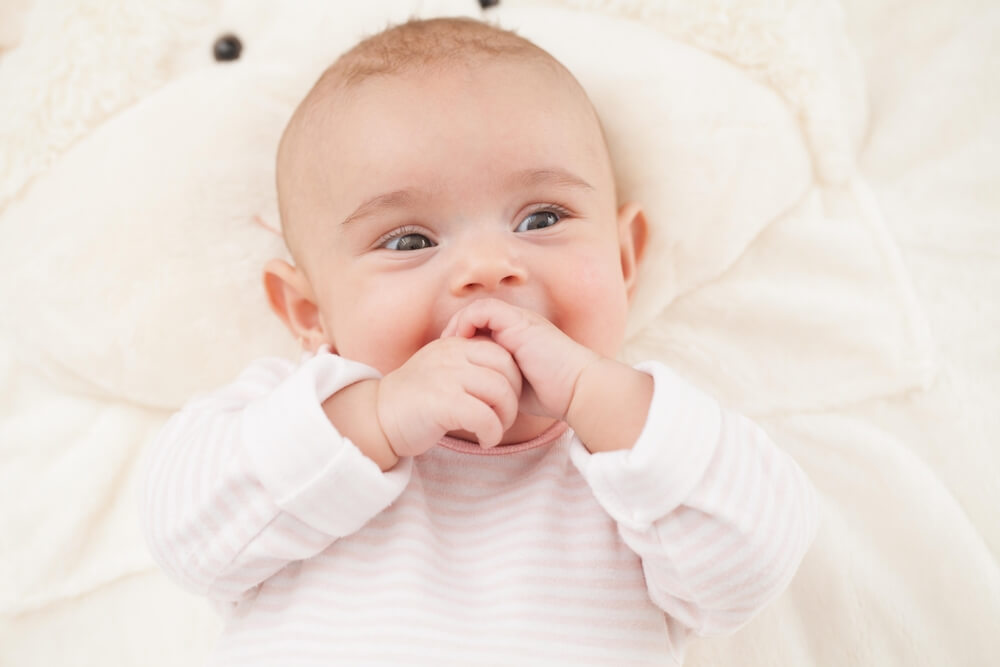
Prostock-studio/Shutterstock.com
By the age of 3 months, the baby continues to have their hearing, sight, smell and touch develop actively.
Eyesight
At the age of 3 months old, the child’s vision is rapidly improving, although it is still far from normal. The baby begins to scrutinize those around them closely and attentively, especially when looking into the faces of people around them. The baby becomes excited and reacts with laughter and other sounds when seeing their parents.
The child can focus on a toy that is 20 cm away from them and follow its movement with their gaze. In order to develop this skill, you can hang a moving toy over the baby’s bed.
Hearing
The baby’s hearing is improving every month. They react to sounds in different ways. For instance, they will respond with crying to loud and harsh sounds, or start worrying and get agitated when hearing familiar footsteps or voices. At the age of 3 months, the child must already turn their head in an attempt to find out where a certain sound is coming from.
Emotions and interactions

Prostock-studio/Shutterstock.com
This age can be summarized in a few words, which are constant eye contact, smiles, gestures, and laughter.
By the age of 3 months, the child begins to experience emotions, hence they start experiencing a great need for communication. Babies react to your voice and your various facial expressions, they look for their mother if they can no longer see her. Children begin to laugh at this age, they already know who their family is and who is a stranger. Nevertheless, they are also able to grace a stranger with a smile. They no longer recognize people by their voice, but rather by their appearance and smell.
The baby communicates with adults with noticeable pleasure. They begin to love playing with others and can even cry of discontent when the entertainment time has come to an end.
The child learns to respond, they gurgle a lot and make more and more sounds.
A 3-month-old baby is more sensitive and can pay attention to an object for a longer period of time. As their muscles develop, the baby begins to reach for the objects that are of interest to them. Although they have not yet learned how to control their hands, they already have a noticeable desire to put something in their mouth.
Doctor’s tips
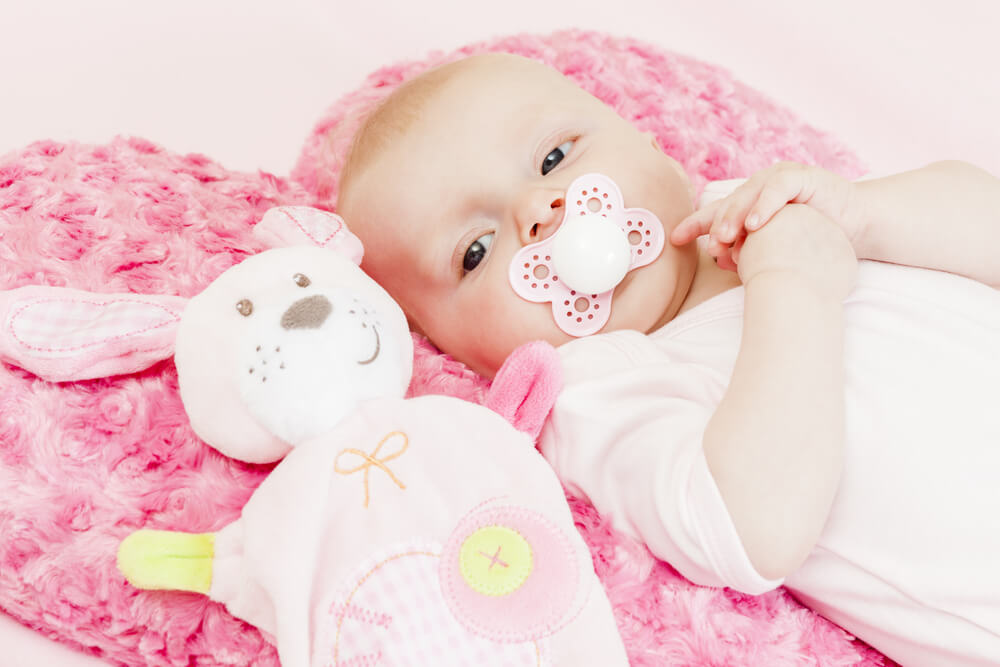
Prostock-studio/Shutterstock.com
If you follow the advice of a well-known pediatrician with many years of experience from the very birth of your child, you will be able not only to raise your baby correctly, but also make your own life much easier. We present some advice from doctors for parents of three-month-old babies below.
Pacifier
At 3 months old, the child should get better sleep. If this does not happen, and the baby is not familiar with the pacifier since birth, young parents strongly suggest giving the baby a pacifier to calm them down. This method works quite often.
In the opposite situation, the baby is inseparable with the pacifier since their birth, and their parents try to separate them from it at the age of 2-3 months. However, according to the doctor, the sucking reflex is extremely important in the life of the baby for many reasons. In this situation, the parents should rely only on the desire and health of the baby, as there should be rationality and moderation in everything.
Rules of healthy sleep
If you have not started getting enough sleep with your baby at night, and their sleep is intermittent and restless, this does not mean that the child has got some health problems. Normal sleep is the result of fulfilling several important conditions, therefore, you have got to ask yourself whether you are doing everything right.
Frequent issues and ways to resolve them. When should you be alarmed and when not?

Prostock-studio/Shutterstock.com
In most cases, the parents of the baby are overly worried about the baby and wind themselves up for no reason. However, babies, just like adults, may be experiencing some serious health issues. It is very important to find a middle ground here, with not worrying about regular minor things and being on the lookout for serious problems.
Here is a list of the problems most commonly faced by parents of a 3-month-old baby.
The 3-month-old crisis
The start of a crisis is clearly distinguishable, it is marked by the dramatic change of a baby’s behavior during feeding. They enjoyed this process on previous occasions, but now they will start grabbing and pinching their mother’s breast, or may even refuse to have breast milk.
It is important for the mother not to stop breastfeeding in this case. They should offer the breast to their baby at any time of the day or night. When the baby is hungry, they will have no choice but to start eating. Be gentle and patient, this period shall soon pass and the nice baby will quickly replace the unhappy baby.
Digestive issues
At the age of 3 months, the baby’s stool should coincide with the frequency of feeding. Usually, by 3 months old, the baby’s stool is getting better. Nevertheless, if constipation has become a common occurrence, you need to figure out the matter for it, it doesn’t always have to be a medical problem. The solution sometimes lies in replacing the milk formula or by revising the mother’s diet during breastfeeding.
Burping may still remain, and this is normal, however, it is important for its quantity not to be too large.
Frequent crying and restless behavior

Prostock-studio/Shutterstock.com
Even too frequent whims are not necessarily caused by some health problems. For many babies, crying during this period can be due to a bad mood or may serve as a signal that the child is bored. However, you should not attach any crying to this or consider this type of baby’s behavior as a way to attract attention.
Remember that children do not know how to manipulate the people around them at the age of 3 months old.
The anxiety of a baby can most often be explained by the following:
- wet diaper;
- hunger;
- tiredness and sleepiness;
- an overstrained nervous system;
- discomfort (being hot or cold);
- tummy problems: colic or constipation.
Crying should be taken seriously in case of illness. Even with a mild cold, a baby can be greatly disturbed by a stuffy nose or ear pains, and the only way for them to report a problem is through crying.
Moreover, some children start having their first teeth early, which also causes great anxiety for the baby, up to the point of having fever and sleeping badly.
It is important to remember that it would be much easier for a child to deal with an illness if they have a calm and composed adult by their side.
Regular crying of the baby for 2-3 hours or more means that you need to see a doctor urgently.
Crying with back arching
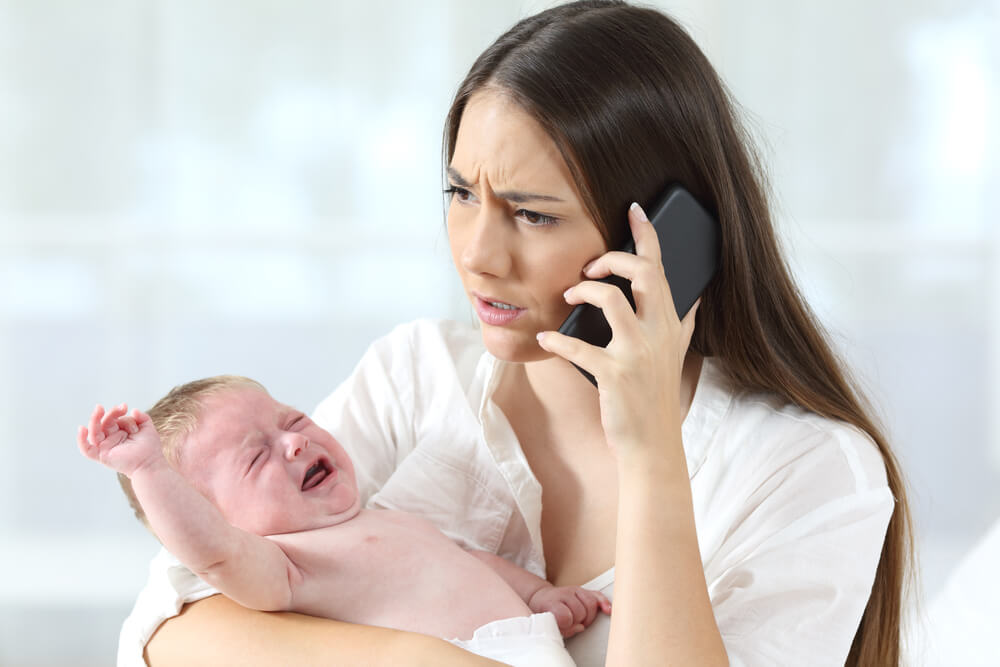
Prostock-studio/Shutterstock.com
If the baby is crying very loudly while arching their back, this is an alarming sign as it may indicate the presence of serious pathologies. Such behavior of a child may be caused by the following:
- intracranial pressure;
- brain tumor;
- encephalitis;
- meningitis;
- disturbed metabolism.
Consult the doctor immediately if you have noticed any of the symptoms described above in your child.
When is assistance required immediately?
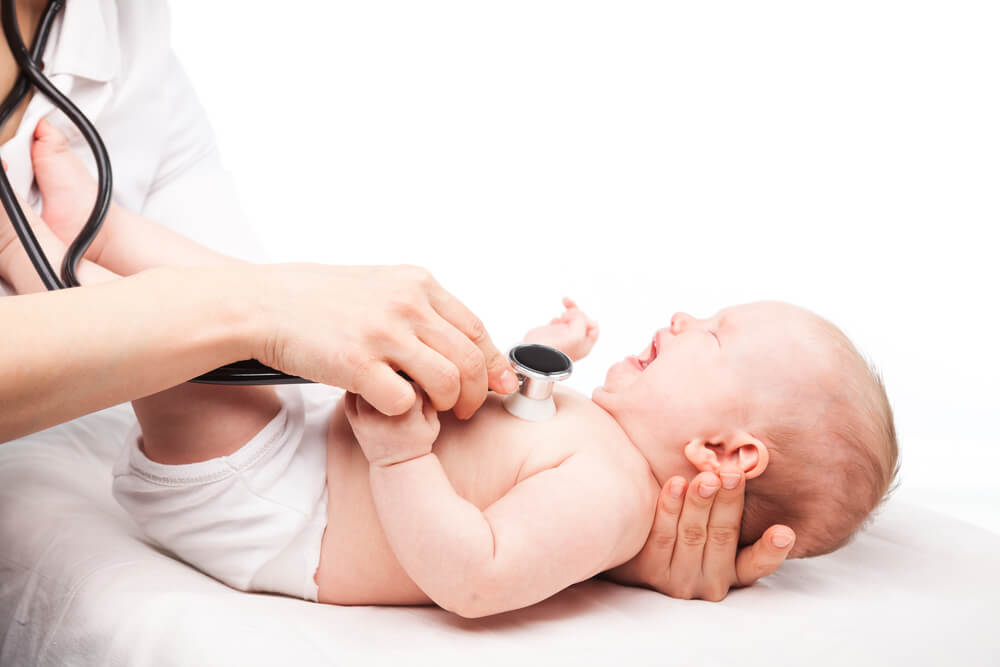
Prostock-studio/Shutterstock.com
Each child develops in their own way and at their own pace. However, you need to pay attention to the factors stated below. If the baby has difficulty with them, this may indicate an illness or developmental problems.
Seeking the advice of a doctor is vital if you have realized that the 3-month-old infant is doing the following:
- has not started smiling;
- does not hold their head for at least 30 seconds when they are being lifted up vertically;
- cannot hold their head for more than 1 minute while lying on their stomach;
- does not pay attention and is not interested in their hands by the age of two months and later;
- does not calm down even for a short while, despite the fact that you are trying your best to comfort them;
- is silent, does not try to make any sounds or babble;
- are still clenching its fists as a reflex;
- their eyes are crossed, as at birth, most of the time;
- does not pay attention to new faces or, conversely, are too frightened at the sight of new people or a change of scenery;
- does not hold any objects, toys, etc.;
- does not follow moving objects with their eyes;
- does not respond to harsh or frightening sounds.
Development of a 3-month-old baby: tips for parents
3 months is the milestone at which language foundations are laid. Sing and read to your baby as much as possible, talk to them. Respond to your child with different sounds or words to encourage them to express themselves. At this age, what you say is not very important, what matters is your intonation.
Choose large books for children with bright and simple pictures. Name the objects, animals, natural phenomena, etc., slowly and clearly, whilst pointing them to the child.
Help your baby to develop and strengthen the muscles of their neck and back: hang a toy or an attractive object in front of them so that they can reach for them when they are lying on their tummy.
Stimulate the baby’s sense of touch. Stroke your baby with objects of different textures, such as fur, felt, or velvet. In addition to the fact that it will diversify your leisure time, such manipulations will also soothe and relax the child.

Prostock-studio/Shutterstock.com
Offer some special adapted books and rugs for the sensory and cognitive development of your child, or create a sensory box yourself.
Do not overwhelm your child with many toys. Just a few pieces are enough for their development. Excessive stress will lead to overstrain of the nervous system and will trigger problems with concentration.
The baby wants to be constantly in their mother’s arms at this time. A swinging baby crib device will help unload the mother and entertain the baby for some time.
Doctors advise anxious parents not to waste their nerves searching for problems. Fortunately, serious illnesses that affect the health and development of the baby are not so common. In addition, the presence of really important and alarming symptoms will usually be immediately noticeable to both you and your pediatrician. Take a deep breath and stop constantly comparing your baby to other children.
Enjoy every minute of your child’s growing up. Tummy problems and sleepless nights will surely be over soon!
Проверьте электронный ящик



















